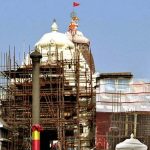 By Nageshwar Patnaik in Bhubaneswar, October 3, 2023: He is the Bada Thakur – the chief among Gods. His is Bada Deula, the chief temple among temples and the path in front of His temple is called Bada Danda, the chief path way. The sea washing the shore of His Khetra is called Mahodadhi, which means the great ocean. Everything related to Lord Jagannath and His temple is unique and extraordinary. His Temple in Puri, boasts of having the biggest kitchen in the country.
By Nageshwar Patnaik in Bhubaneswar, October 3, 2023: He is the Bada Thakur – the chief among Gods. His is Bada Deula, the chief temple among temples and the path in front of His temple is called Bada Danda, the chief path way. The sea washing the shore of His Khetra is called Mahodadhi, which means the great ocean. Everything related to Lord Jagannath and His temple is unique and extraordinary. His Temple in Puri, boasts of having the biggest kitchen in the country.
Not surprisingly, he continues to be the biggest land lord in the country with over 60,822 acres of land in Odisha and six other states, Odisha Law Minister Jagannath Saraka informed the assembly on Saturday in a written reply to a question from BJD member Prasanta Behera.
The food offered to Lord Jagannath is known as Mahaprasad. Around 500 cooks and 300 helping hands prepare 56 different offerings known as ‘Mahaprasad’ for Lord Jagannath, which are served to the deity six times a day. Every devout Hindu preserves Nirmalya or dry Mahaorasad. The kitchen has 32 rooms, 752 stoves and nine earthen pots. Some 3000 families directly or indirectly depend on this Kitchen and the annual turnover from Mahaprasad business is pegged around Rs 30 crore.
There are about 1342 sevayat [servitor] families dedicated to this 12th century Temple, according to the latest census carried out by the Temple authority recently. Round the year 1700 servitors serve the Lord uninterrupted as per the rituals. On top of that about 1500 non-servitors are engaged in various services to carry on theage-old tradition.
The system of worship of Lord Jagannath and other deities and rituals in their present form, have an unbroken tradition over 800 years. Needless to say, the maintenance and administration of this great temple is like a small state within a big state.
 During the British Rule, the Raja of Puri was appointed as Raja Superintendent to manage the temple administration. After independence, the Orissa Government passed “The Puri Shri Jagannath Temple (Administration) Act, 1952” with provisions to prepare the Record of Rights and duties of Sevayats and such other persons connected with the system of worship and management of the temple. Subsequently, “Shri Jagannath Temple Act – 1955 ” was enacted to manage the affairs of the temple and its properties. The Act only came into force from December 27, 1960 because of long drawn legal battles.
During the British Rule, the Raja of Puri was appointed as Raja Superintendent to manage the temple administration. After independence, the Orissa Government passed “The Puri Shri Jagannath Temple (Administration) Act, 1952” with provisions to prepare the Record of Rights and duties of Sevayats and such other persons connected with the system of worship and management of the temple. Subsequently, “Shri Jagannath Temple Act – 1955 ” was enacted to manage the affairs of the temple and its properties. The Act only came into force from December 27, 1960 because of long drawn legal battles.
For ages, the temple economy was land based and 98% of the land was cultivated by tenants. Just after the abolition of the abolition of estates in 1956; the temple came under stress with income from land dwindling. At the same time, there was a sharp rise in prices of all materials required to manage the rituals of the Lord.
The minister further clarified that a total 60,426.943 acres of land in the name of Mahaprabhu Jagannath Bije, Srikhetra Puri, have been identified in 24 of the 30 districts of Odisha.
Of these, the Shree Jagannath Temple Administration (SJTA) has received the final Record of Rights (RoR) over 38,061.892 acres of land, he said.
Similarly, 395.252 acres of land in six other states were identified in the name of Lord Jagannath, Mr Saraka said.
The minister said that the temple has already lodged 974 encroachment cases in different tehsils of the state to remove illegal encroachments.
The cases were filed as per the provision of the Shri Jagannath Temple Act, 1955, after the conduct of a proper inquiry by SJTA officials.



Leave a Reply
Be the First to Comment!